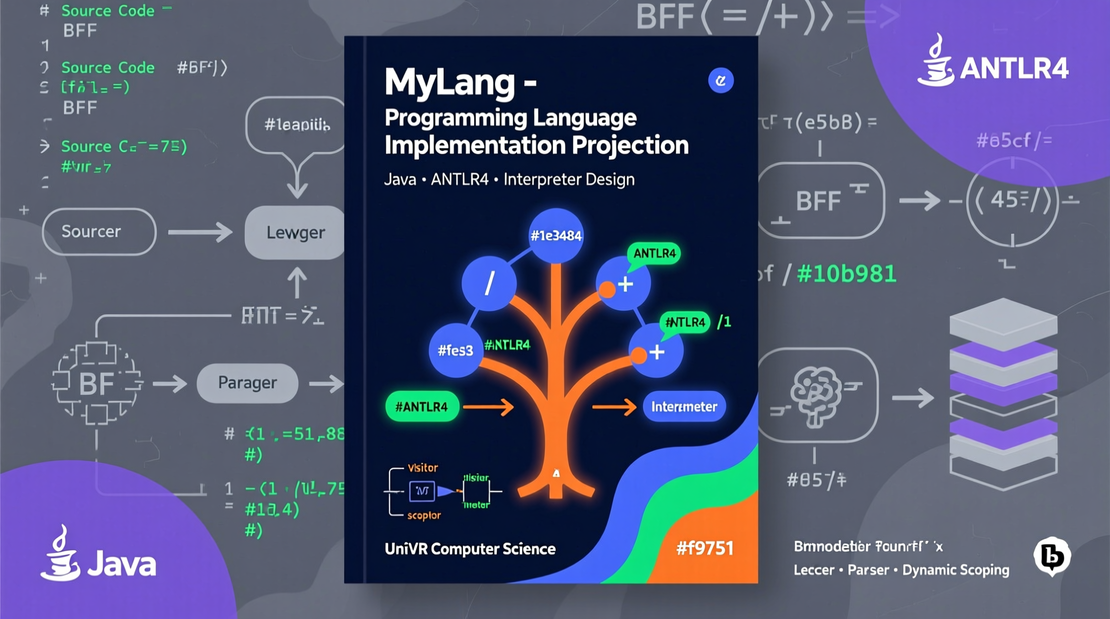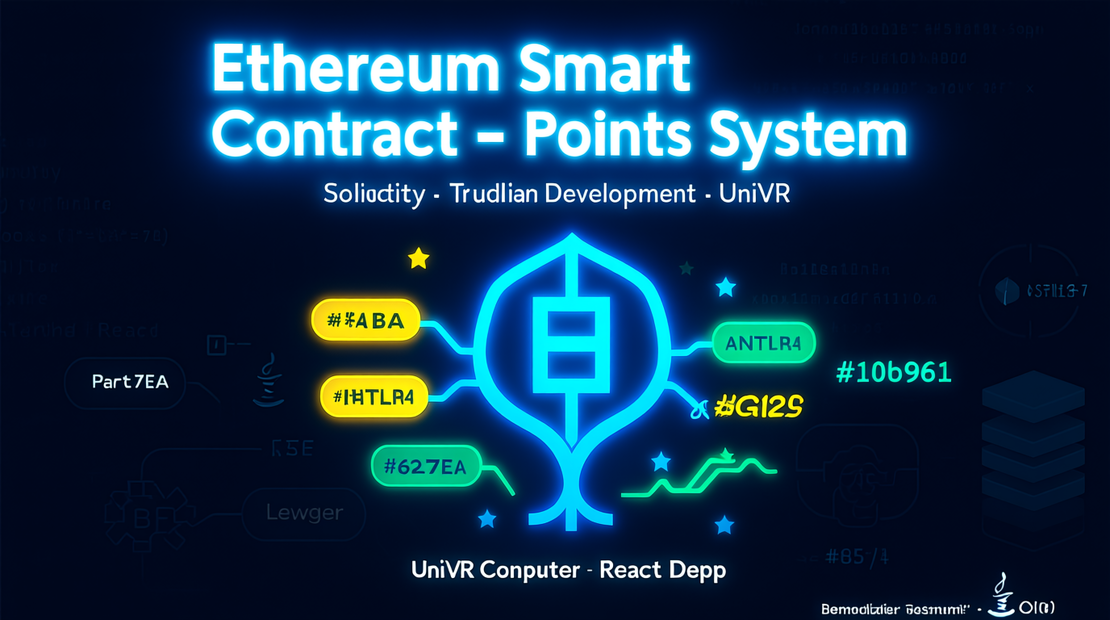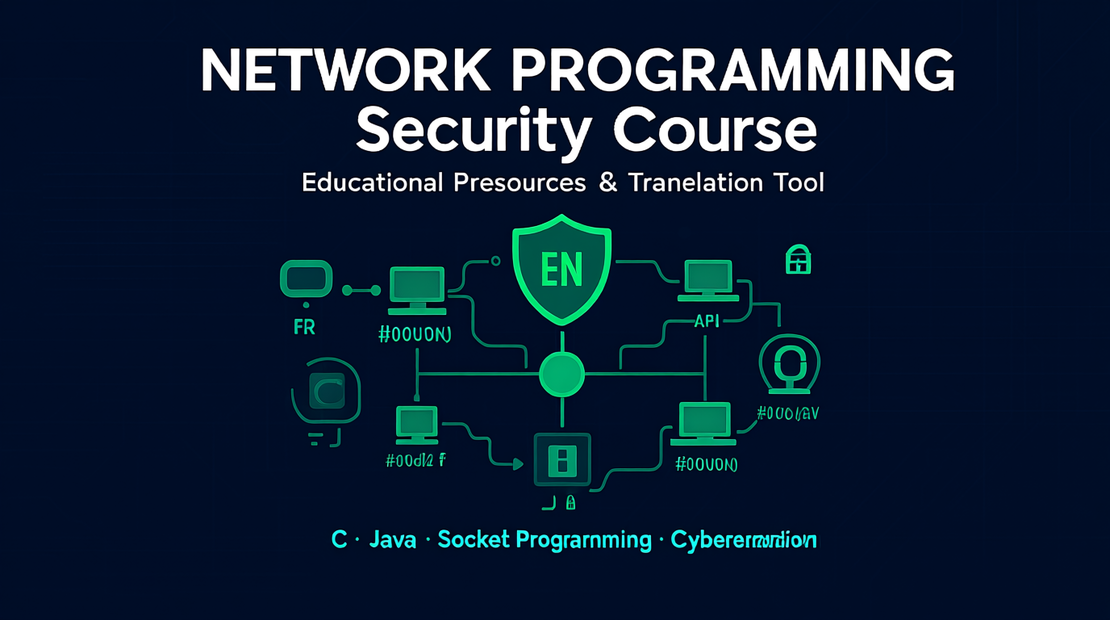
MyLang - Implementazione Completa di un Linguaggio di Programmazione
- Tech projects
- September 18, 2024
Table of Contents
The Genesis of the Project: From Abstraction to Concrete Implementation
The Programming Languages course at the University of Verona represents one of the most fascinating moments of the Computer Science curriculum: the moment when one moves from the use of languages to their creation. When the professor announced the lab project—implementing a programming language from scratch—I saw the perfect opportunity to combine theoretical passion and practical application.
The challenge was ambitious: not only to understand the internal mechanisms of parsing, interpretation, and execution, but to concretely implement them, creating a working language that could also be useful to my colleagues as a study reference.
From Concept to Community: Sharing to Grow Together
As with my previous projects, I immediately thought about how this work could benefit the entire student community. Implementing a programming language is a complex task that many students find intimidating, especially when dealing with:
- Lexical analysis and syntax
- Abstract syntax trees
- Memory management and scope management
- Runtime error handling
- Integrating different paradigms
I therefore decided to document every aspect of the process, creating a resource that could guide other students through the complexities of implementation.
MyLang Architecture and Design
Core Technology Stack
- Java: Host language for robustness and portability
- ANTLR4: Parser generator for managing complex grammars
- Visitor Pattern: For AST traversal and interpretation
- Exception Handling: For elegant runtime error handling
Innovative Language Features
🧠 Dynamic Type System
- Multi-type support: integers, floats, strings, arrays
- Intelligent type coercion for mixed operations
- Runtime type checking with detailed error reporting
- Automatic memory management for data structures
🔄 Advanced Scope Management
- Dynamic scoping with call stack management
- Lexical scoping for variable shadowing
- Independent environments for functions
- Global variable synchronization controlled
⚡ Extended Control Constructs
- Standard control flow: if/else, while, for loops
- Non-deterministic execution: unique construct for algorithmic exploration
- Function declaration without parameters for simplicity
- Return mechanism via exception handling for control flow
Distinctive Technical Innovations
Native Brainfuck Integration
One of the most interesting features of MyLang is the complete integration of the Brainfuck language, allowing:
- Native execution of Brainfuck code within MyLang
- Interoperability between the two paradigms
- Educational value for understanding esoteric languages
- Demonstration of flexibility of interpreter architecture
Parser Generation with ANTLR4
The use of ANTLR4 for automatic parser generation demonstrates:
- Grammar-driven development for formal languages
- Separation of concerns between syntax and semantics
- Maintainable codebase through grammatical declarations
- Professional tooling for language development
Implementation of Core Components
Automated Lexers and Parsers
// Automatic generation from ANTLR4 grammar
@Override
public Value visitProg(MyLangParser.ProgContext ctx) {
return visitChildren(ctx);
}
Evaluation Visitor Pattern
- Systematic AST Traversal for interpretation
- Type safety through Value wrapper classes
- Controlled error propagation via exceptions
- State management for execution context
Advanced Memory Model
- Stack-based scoping for function management
- Heap allocation for dynamic data structures
- Implicit garbage collection via Java runtime
- Automatic variable lifecycle management
Educational Impact and Community Value
Comprehensive Educational Resources
The project provides:
- Step-by-step implementation guide
- Extensive code comments for each component
- Architecture documentation for design decisions
- Comprehensive test cases for validation
Reference Implementation
- Best practices for language implementation
- Design patterns applied to compiler construction
- Error handling strategies for production quality
- Performance considerations for Interpreter Optimization
Design Choice Analysis
Scoping Strategy: Dynamic vs. Lexical
The choice to implement dynamic scoping as the default with lexical support demonstrates:
- Flexibility in exploring different paradigms
- Educational value in understanding trade-offs
- Elegantly managed implementation complexity
- Predictable and debuggable runtime behavior
Exception-Based Return Mechanismsm
The use of Java exceptions to implement return statements demonstrates:
- Creative problem solving for language features
- Leveraging host language capabilities
- Clean control flow management
- Well-documented performance implications
Development and Testing Methodology
Incremental Development
- Feature-driven implementation with continuous testing
- Modular architecture for parallel component development
- Version control for tracking language evolution
- Documentation parallel to code development
Comprehensive Testing Strategy
- Unit tests for each individual component
- Integration tests for complete workflows
- Error condition testing for robustness
- Performance benchmarking for optimization
Contribution to Computer Science Education
Democratizing Language Implementation
The project demonstrates that language implementation is not the exclusive prerogative of advanced computer scientists, but can be:
- Accessible to Undergraduate students with a systematic approach
- Educational to understand fundamental principles
- Practical to develop implementation skills
- Collaborative through code and documentation sharing
Bridge Between Theory and Practice
MyLang serves as a concrete bridge between:
- Formal language theory and real-world implementation
- Abstract concepts of parsing and concrete execution
- Academic knowledge and industry-relevant skills
- Individual learning and community contribution
Lessons Learned and Best Practices
Language Design Principles
- Simplicity as a foundation for understandability
- Syntactic consistency for user experience
- Architectural extensibility for future evolution
- Informative error messages for effective debugging
Implementation Strategies
- Tool selection appropriate for problem complexity
- Incremental complexity for development management
- Documentation-driven development for maintainability
- Community feedback integration for continuous improvement
Roadmap and Future Enhancements
Planned Language Features
- More sophisticated type system with inference
- Module system for code organization
- Standard library for common functionality
- Just-in-Time compilation for performance improvements
Educational Expansion
- Interactive tutorials for language features
- Visual debugger for execution tracing
- Comparative analysis with other languages
- Workshop materials for teaching compiler construction
A Model for Collaborative Learning
This project exemplifies how individual academic excellence can be transformed into a collective resource through:
- Open source mindset from inception
- Documentation excellence for knowledge transfer
- Community engagement for feedback and improvements
- Educational impact that goes beyond a single course
Conclusions: From Implementation To Inspiration
MyLang represents more than just a university project: it is a concrete demonstration that the complexity of programming language implementation can be demystified through a systematic approach, excellent documentation, and a spirit of sharing.
The project continues to serve the UniVR student community as a reference implementation and learning resource, demonstrating that investing in quality and documentation yields lasting benefits for entire generations of students.
Tags :
- Programming languages
- Language implementation
- Interpreter design
- Java programming
- Antlr4
- Lexical analysis
- Syntax parsing
- Compiler theory
- Abstract syntax tree
- Language design
- Educational resources
- University project
- Uni vr
- Computer science
- Brainfuck integration
- Dynamic scoping
- Exception handling
- Non deterministic execution


